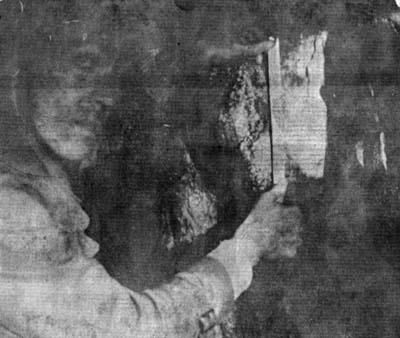 |
||
 About Stonelight |
Wonders of Dowth are uncovered Sun Calendar unique says U.S. Researcher. By John Kelly
Miles overhead a jet cruises chalking geometrical white lines through the evening sky, the perfection of thousands of years of man's scientific development. The irony of it is that, down here, on the soaked, clinging clay of Co. Meath, it might have all begun, if the theory of a 38-year-old New Yorker, whose family originated in Lough Glynn, Co. Roscommon, is right. Daily, at this remote, almost magical spot called Dowth, Brooklynite Martin Brennan has been charting the progress of the sun towards this evening at four p.m. when it will set on the shortest day of the year, solstice. Equipped with the best available data from the Irish Meteorological Office, gleaned from weather satellites, Martin Brennan pours over the mysteries of Neolithic culture - and he is absolutely convinced that Dowth's two tiny apertures, leading into what were previously regarded as elaborate burial chambers, are opening out on the astronomical wonders of the universe. In short, he is positive that Dowth, Knowth and Newgrange, three tumuli on the high ground of Co. Meath, are highly advanced astronomical observatories, designed by Neolithic man as an elaborate calendar, and largely misunderstood since. He is not the only one. Local people have always been aware of the phenomenal 'coincidences' regarding the interplay of sun and moon at the sites. And, on the day we visited three medical doctors, all members of the same family, from Stuttgart in Germany, were studying the Dowth phenomenon for the second year in succession. Like Mr. Brennan, they are convinced that Ireland possesses the oldest, most elaborate, and totally unique astronomical observatories in the world. And, indeed, the 'coincidences' are remarkable. For example, today at four p.m. approximately, the setting sun will shine directly over Newgrange, clearly visible from Dowth. Its rays will penetrate the tiny aperture which leads into one of the main chambers. Symbol Given that there is little cloud cover, the chamber will then flood with light and the sun will beam directly onto a circular symbol at the top of a row of triangles, carved in the huge, flat, 'picture screen' type of stone which directly faces the aperture. The effect is almost like a lantern slide, with the sunlight streaming on to the stone, illuminating the circle for a few minutes, as it has done, on this one day of the year, for approximately five thousand years. As it does so, the solstice, full moon will rise directly overhead, facing the setting sun in a straight line, to set finally over Knowth, the third Co. Meath tumulus. Thus, all three mounds will be seen to be strategically sited in mathematical precision to record the changing seasons, something we now tend to lake for granted, but an ability that was particularly essential for Neolithic man. Mr. Brennan, who studied 'visual communication' in the Pratt Institute in the United States, is not only convinced that the coincidences are too remarkable to be accidental. After ten years research throughout Ireland, he reckons that he has accumulated more than enough scientific evidence to show that most such tumuli, which are found in almost every county, were designed in the same fashion with the same deliberate aim in mind to predict the changing of the seasons. Similar The symbols in the Irish tumult are almost exactly alike throughout the country. And they are remarkably similar to other stone-age carvings in Mexico, depicting the sun and the moon, which Mr. Brennan has also studied and are now generally accepted by archaeologists to have been used as seasonal 'dead reckoners'. However, he claims that the Irish based tumuli are much more sophisticated; with important differences suggesting independent development. Even more significant from the scientific point of view, they still work and seeing is believing, says Mr. Brennan. Along with his co-researchers Mr. Jack Roberts, he also claims to have cracked' the meaning of the symbols in Newgrange, Dowth and other Neolithic chambers throughout the country. They were clearly designed as a calendar, he claims, precisely charting the position of moon and sun even on a daily basis. Although some archaeologists tend to pour cold water on his theories, preferring to regard the tumuli as ceremonial burial chambers, the astronomical world, at least, is treating his findings very seriously. Last Friday, he was invited to describe his research to a distinguished international gathering of astronomers at Dunsink. And his publishers, Thames & Hudson, are helping to finance the work of the two men in anticipation of their book, The Stars and the Stones. The book will be far removed from the realm of speculation. The publishers and co-authors are determined to ensure that it will concentrate on the facts, gleaned from their researches, and on the observed, scientific data. Probability will be clearly described as such. Mr. Brennan is a little perturbed at the criticism of some Irish archaeologists and he is at pains to insist that his speciality, Neolithic stone engravings, is at the base of all his research. In fact, he says that
was why he first came to Ireland eleven years ago after being
urged to do so by a well known academic in Japan where he was
then studying eastern civilisation. After his arrival, he lived
in a house in the Boyne Valley. Since then, he has pored over the mystery of the "stones" and is daily entranced at the new evidence of the advanced Neolithic civilisation which is still regarded by most authorities as "primitive". Experts are still studying Mayan and Egyptian artefacts. Stonehenge is now almost totally accepted as being a significant early "observatory". Both the biggest and most sophisticated, in the world has been neglected," he says enthusiastically. "It is, by far, the most important and is much more complex and sophisticated than Stonehenge. It's fascinating. It works now just as it did thousand's of years ago. We are studying astronomy here just as did the people who lived here in the Stone Age. In fact, the entire thing is a window on their civilisation. We're getting insights into the beginning of civilisation, the beginning of geometry and astronomy. "We're not dealing here with the artefacts of savages in the wilderness, or with people who ran from the sight of their first eclipse. We're dealing with people who could even determine when an eclipse could occur." Mr. Brennan is absolutely positive that his book will convince the most sceptical. And he hopes that Irish archaeologists will gradually come around to his way of thinking, as he asserts, some have. "My speciality has always been design, particularly the deign of the Neolithic period. I'm not joking when I say that I have solved the meaning of the carvings on the stones inside the mounds. I'm not alleging that they were not also used as burial chambers. Obviously they were. Nor am I even saying that they could not have served a dual function at the same time, although it is possible that they were used by later civilisations only as chambers. "I am saying that their primary function was to act as an enormous, absolutely precise, calendar. The similarity in the mounds are too remarkable to be coincidental." Influence But who were they - these strange, Stone Age geniuses, who could devise such a complex system, and incidentally, exercise a remarkable degree of influence and power as a result? Were they settlers the precursors of the Celtic druids who came after? Mr. Brennan ventures delicately into this territory. It is, after all, speculation, and he is wary of being accused of that. But he does say that he can see no reason why they should not have been indigenous to the island. After all, there is no evidence of such sophisticated 'clocks' else-where. And they were almost certainly an agricultural people, for whom seasonal change would have been of enormous sociological and perhaps religious importance. It is in this realm of speculation that the imagination can soar to great heights indeed and that one can remember the legends of childhood, of a remote Irish past, unresolved, of the mythical Fir Bolg, and most of all, the Tuatha de Danaan, the 'wizard' people flourishing, perhaps, amid the lush Meath pastures before even the Celts arrived. |
Boyne Valley Private Day Tour Immerse yourself in the rich heritage and culture of the Boyne Valley with our full-day private tours.
Visit Newgrange World Heritage site, explore the Hill of Slane, where Saint Patrick famously lit the Paschal fire.
Discover the Hill of Tara, the ancient seat of power for the High Kings of Ireland.
Book Now
Immerse yourself in the rich heritage and culture of the Boyne Valley with our full-day private tours.
Visit Newgrange World Heritage site, explore the Hill of Slane, where Saint Patrick famously lit the Paschal fire.
Discover the Hill of Tara, the ancient seat of power for the High Kings of Ireland.
Book Now
|

